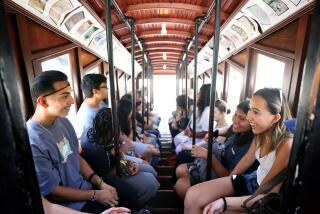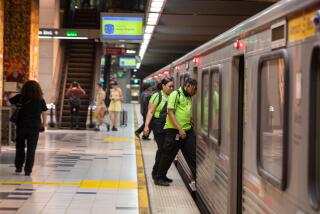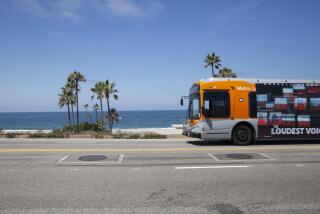Not the Tourist Route : Foreign Students See Seamy Side of N.Y.
- Share via
NEW YORK — There are plenty of people who are eager to show foreign students the Statue of Liberty, the Empire State Building and the Bronx Zoo. Metro-International offers another side of New York:
A shift working in a shelter for the homeless. A walking tour of Harlem. A ride on the subway with a transit police officer who offers advice on how to avoid muggers.
“Our approach is to help the students understand our society and all the things they’re seeing,” says executive director Stacey Klein. “We want them to understand how our society works--and also how it struggles.”
Since 1977, when Metro-International was formed by foreign student advisers from seven schools, it has expanded to serve students from 60 colleges and universities in the New York area.
Not all activities involve New York’s seamy side. Each week, 15 to 100 students sign up to do things such as tour the Pennsylvania Dutch country during Thanksgiving weekend or man water stations at the New York Marathon.
Metro-International also publishes a “Guide to Living in New York.” According to this booklet, the subway can be “a very unpleasant and frightening experience.” Driving a car in the city is “costly and exhausting.” Manhattan residents are “without question the most smug city dwellers.”
“My life in New York would have been completely different without this organization,” says Dinyar Master, an architect who came from India 6 years ago to study at Pratt Institute in Brooklyn.
“Certain things one can do--one can go to the movies or an opera,” he says.”But it’s not the same as when somebody takes you around the back streets.”
Taste of Soup Kitchen
At a recent weekend workshop on the homeless, students worked in a soup kitchen, distributed sandwiches to the homeless in Grand Central Station, spent the night in a Quaker-run shelter on the Lower East Side and learned about the causes of homelessness.
Students such as Yvonne Kwong of Hong Kong, who is studying marketing at Pace University in Manhattan, say they are shocked to see people sleeping on the street in such a rich country. The workshop helped them understand “how come there’s homelessness, because of the housing problem, and maybe they are alcoholics or mentally ill,” says Kwong.
The workshop on the homeless is one of several that enlist the students as volunteers. In other such programs, students work as farmhands in upstate New York and speak about their native lands at public high schools.
Metro-International has a staff of just two: Klein and Andrea Nemetz. Its $150,000 annual budget money is supplied by corporations, foundations, the United States Information Agency and the council that supports Fulbright Scholars. Students are charged $3 to $5, plus transportation, for each event.
One of its most popular programs sends students into the homes of suburban families for a day or weekend visit.
“They help us get to know the American life style; they take us to their homes, and I think that’s important for foreigners,” says Firdaus Djailani, an Indonesian pursuing a master’s degree in business administration at St. John’s University in Queens.
In a city that can be intensely lonely for a newcomer, Metro-International also gives foreign students an opportunity to socialize with each other.
“I think most Americans are friendly, but they don’t have time to talk to us. They have their own lives and their own schedules,” Djailani says.
In contrast, Master says, foreign students “all have a common background, so whatever problems we do have, we have a chance to share them.”
Americans play an important role in one program--a trip to Yankee Stadium. American “baseball buddies” sit next to the foreign students and explain the game.
But even a visit to Yankee Stadium offers a hard lesson about life in the Big Apple.
“Mets tickets,” Klein says, “were too hard to get.”
More to Read
Sign up for The Wild
We’ll help you find the best places to hike, bike and run, as well as the perfect silent spots for meditation and yoga.
You may occasionally receive promotional content from the Los Angeles Times.






